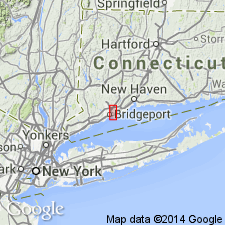
- Usage in publication:
-
- Ansonia Leucogranite
- Modifications:
-
- Redescribed
- Revised
- Age modified
- Geochronologic dating
- Dominant lithology:
-
- Leucogranite
- AAPG geologic province:
-
- New England province
Summary:
Ansonia gneiss is here referred to as Ansonia leucogranite. On the basis of field and laboratory studies, Ansonia, Beardsley, Pumpkin Ground, and Shelton gneisses, previously considered stratigraphic units, are reinterpreted as plutonic. Ansonia is described as a strongly lineated and moderately foliated, fine-grained, garnet-bearing, biotite-muscovite leucogranite with a well-developed granoblastic texture. Intrudes Beardsley and Pumpkin Ground orthogneisses. Maximum age from zircons is 417+/-1.5 Ma. Conservative interpretation of isotopic data is crystallization between 393 and 419 Ma and therefore, authors assign an age of 406+/-13 Ma (Late Silurian to Early Devonian) to the Ansonia.
Source: GNU records (USGS DDS-6; Reston GNULEX).
For more information, please contact Nancy Stamm, Geologic Names Committee Secretary.
Asterisk (*) indicates published by U.S. Geological Survey authors.
"No current usage" (†) implies that a name has been abandoned or has fallen into disuse. Former usage and, if known, replacement name given in parentheses ( ).
Slash (/) indicates name conflicts with nomenclatural guidelines (CSN, 1933; ACSN, 1961, 1970; NACSN, 1983, 2005, 2021). May be explained within brackets ([ ]).

